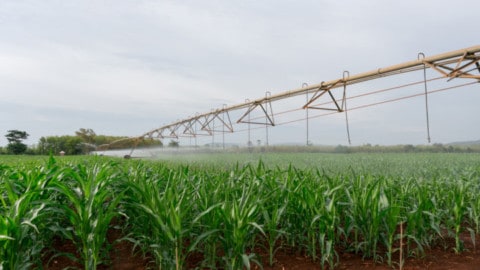South East Water, which delivers water, sewerage and recycled water services to 1.87 million people in Melbourne’s south east, is investigating new ways to use biosolids – a by-product of the wastewater treatment process. Farmers can use this nutrient-rich fertiliser to maintain soils and stimulate plant growth, which increases their productivity, but there are restrictions on how biosolids can be used that limit their effectiveness.
Supported by the Cooperative Research Centre for High Performance Soils (Soil CRC) and partnering with the University of Newcastle, South East Water is trialling soil injection of biosolids in liquid form to improve soil structure, fertility and function at its Longwarry Water Recycling Plant.
If successful, the project has the potential to influence Environment Protection Authority (EPA) guidelines on liquid injection of T3 grade biosolids in Victoria, which is not a biosolids management option sanctioned by EPA Victoria.
“We hope to prove that using biosolids in liquid form (known as T2 or T3 treatment grade) is appropriate for use on agricultural crops. This would permit time and cost efficiencies through bypassing conventional drying and stockpiling processes,” South East Water’s Senior Research and Planning Scientist, Dr Aravind Surapaneni, said.
“By undertaking this trial we can assess the impact of using T3 grade liquid biosolids on crops, as well as identifying any potential risks of using this by-product.”
The trial started in October 2018 and is scheduled to be completed by October 2020.
The specific objectives of the trial include:
- Identifying and quantifying potential on and off-site environmental risks and impacts as well as potential contaminant/emission sources, pathways and end points (fate of known
contaminants/nutrients) - Generating scientific knowledge and understanding on biophysical and chemical soil properties and processes associated with liquid biosolids injection
- Assessing the agronomic benefits of soil injection of liquid biosolids
The long-term objective is to develop guidance/policy documents for future regulations and compliance in relation to soil injection of liquid amendment, in association with EPA Victoria and other regulatory agencies across Australia.
In the Victorian context, biosolids are classified by treatment (pathogen reduction/stabilisation grades T1, T2 and T3) and contaminant grades (C1 and C2). The treatment grades are based on the process used to stabilise and dry the sludge, and seek to protect human health and the environment from a microbiological contamination perspective.
The current method for producing biosolids that meet treatment grade T1 – the only type of biosolids deemed safe for unrestricted use as fertiliser on farms – involves a lengthy treatment process, which includes storing the product for a minimum of three years before it’s used.
The agronomic benefits associated with soil injection of liquid biosolids and liquid food wastes are that it delivers nutrients, organic matter and moisture directly into the soil surrounding the plant root, aiding in plant growth and health.
An efficient and cost-effective alternative
EPA Victoria approved the utility’s request to undertake the trial through its Research, Development and Demonstration pathway. Water organisations have used liquid biosolids in Australia since 1998, but all applications so far have been limited to New South Wales.
The current strategy for biosolids management at the Longwarry Water Recycling Plant is to take the sludge-laden Facultative Lagoon 1 offline and dry the sludge in-situ. Sludge is then harvested and taken to Pakenham Water Recycling Plant (around 35km away) for further drying and storage for a minimum of three years, in order to achieve T1 status.
This process is problematic for South East Water (and the water industry at large) as it is costly, time consuming, labour intensive and requires double handling of transport.
Additionally, the end-product has a lower nutrient value due to the long storage times associated with the current practice.
“At South East Water, we’ve been managing biosolids from water recycling plants through agricultural land application for the last fifteen years. The biosolids are produced from liquid sludge, which is removed from the treatment lagoons and dried on site,” Dr Surapaneni said.
“To achieve top quality biosolids as prescribed by EPA Victoria, the dried biosolids should then be stored for a minimum of three years for further drying and be devoid of pathogens. This process is costly, time consuming, labour intensive and requires vast tracts of land. In addition, the nutrient value of the three-year old biosolids also decreases due to the long storage time.
“Hence, we proposed the on-site utilisation of liquid biosolids via soil injection as an alternative cost-effective solution for liquid biosolids management.
“Since the proposed plan was to utilise lower grade liquid biosolids, it required a scientific study for agricultural application approval by EPA Victoria. Therefore, we decided to collaborate with the University of Newcastle for scientific expertise and successfully submitted a project proposal to the Soil CRC in December 2018.”
Establishing the benefits for both the water and agricultural sectors
South East Water has completed the first part of the trial, which has seen a bumper crop of summer forage sorghum produced from liquid injection of biosolids under dryland conditions.
South East Water celebrated the success of the project so far with its partners by hosting a biosolids field day with more than 100 industry professionals, members of the farming community and researchers at Longwarry Water Recycling Plant.
University of Newcastle Environmental Remediation Researcher and one of the project investigators, Dr Balaji Seshadri, said optimising the use of biosolids will result in high value products that can enhance agricultural productivity and soil health.
“Delivering nutrients and organic matter in biosolids to the root zone via liquid injection is one novel approach we’re exploring through this joint trial that will ultimately benefit Australia’s farming community,” Dr Seshadri said.
Soil CRC CEO, Dr Michael Crawford, also believes this project is vital.
“In addition to addressing an important issue for the water sector, it provides scientists and farmers with an understanding of how the addition of organic matter and nutrients to the subsoil can improve soil productivity and ultimately, farmer profitability.”
The Soil CRC is the biggest collaborative soil research effort in Australia’s history. It brings together 40 partners from universities, farmers’ groups, state agencies and industry, including South East Water, with the aim of helping farmers increase their productivity and profitability by providing them with knowledge and tools to improve the performance of their soils.
Dr Surapaneni said if successful, the project will provide a number of benefits to both the water and agricultural sectors.
“It will provide regulatory authorities and the water industry with evidence-based scientific information on alternative courses of action relating to utilisation of biosolids, with a particular emphasis on soil injection of sludge.
“It will also provide best management guidelines on soil injection of sludge leading to significant environmental, economic and social benefits to us as an organisation, and the greater water industry in general.
“For the agricultural sector, it will demonstrate and establish the benefits (soil and agronomic), impacts (especially environmental) and costs (financial and carbon) associated with direct injection of sludge into soil at a well-controlled and confined test site. This will happen under prescribed management practices as well as prevailing environmental conditions for the specified evaluation period.
“We’ll be providing results direct to farming groups, such as Western Port Catchment Landcare Network, via field days, newsletters and websites which will have wider circulation for farmers.”

















